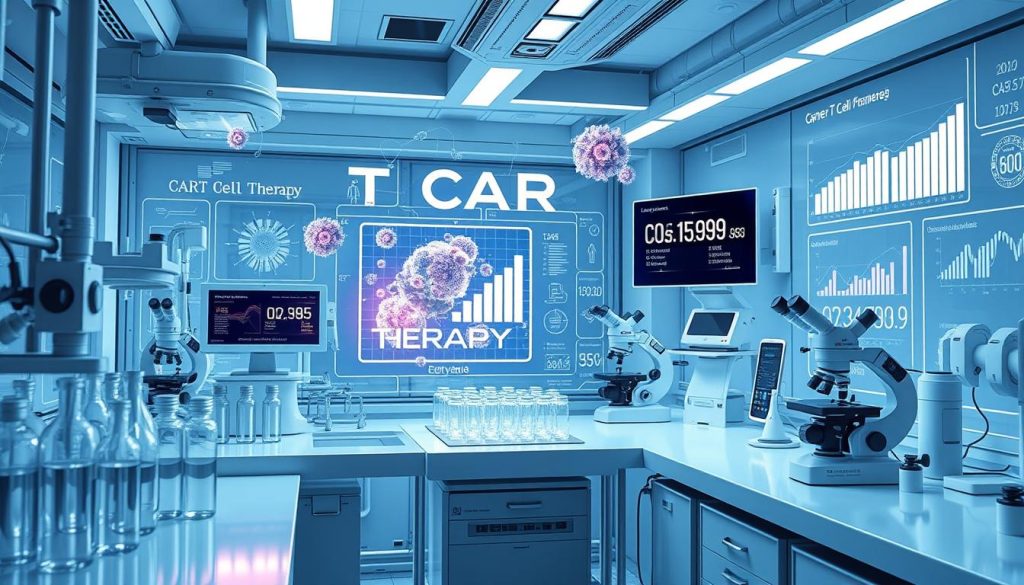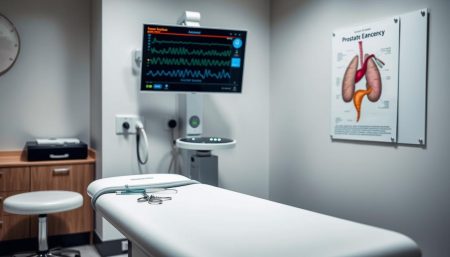Car T cell therapy is a new way to fight cancer, showing great success in some blood cancers. But, the cost of this therapy worries many patients and their families. This guide looks at what affects the price of car T cell therapy in 2024. We’ll also cover the costs and help available for those needing this treatment.
Knowing how much car T cell therapy costs is key for those considering it. We’ll look at insurance, what you might pay yourself, and how cancer type and where you get treatment can change costs. Our goal is to help patients and their families understand the financial side of CAR T cell therapy better.
Understanding the Basics of CAR T Cell Therapy
CAR T cell therapy is a new way to fight cancer. It uses the body’s immune system to attack cancer cells. This method has shown great promise in treating blood cancers like leukemia and lymphoma. But, the cost of CAR T cell therapy is a big worry for many.
How CAR T Cell Therapy Works
To start, a patient’s T cells are taken out. These are special white blood cells. Then, they are changed in a lab to find and kill cancer cells.
The changed T cells are grown more and put back into the patient. There, they keep growing and find and kill cancer cells.
Benefits and Risks of CAR T Cell Therapy
There are many good things about CAR T cell therapy:
- It targets cancer cells directly
- It can lead to long-term remission or even a cure
- It has fewer side effects than traditional treatments
- It works well for patients who haven’t responded to other treatments
But, there are also some downsides:
- Cytokine release syndrome (CRS), a serious immune reaction
- Neurological problems that can cause confusion or seizures
- It’s very expensive, with costs over $500,000
- It’s not available everywhere, only at special centers
The table below shows the good and bad sides of CAR T cell therapy:
| Benefits | Risks |
|---|---|
| Targeted cancer treatment | Cytokine release syndrome (CRS) |
| Potential for long-term remission | Neurological toxicities |
| Fewer side effects than chemotherapy | High treatment expenses |
| Effective for treatment-resistant cancers | Limited availability and access |
As more research is done, we need to make CAR T cell therapy more affordable and accessible. Patients, doctors, insurers, and policymakers must work together. This way, more people can get this promising treatment.
Factors Influencing CAR T Cell Therapy Cost
The cost of CAR T cell therapy can change a lot based on several key factors. Knowing these can help patients and their families understand the financial side of this treatment. It helps them make informed decisions about their care.
Type of Cancer Being Treated
One big factor is the type of cancer being treated. CAR T cell therapy cost comparison shows that treating acute lymphoblastic leukemia (ALL) is more expensive than non-Hodgkin’s lymphoma (NHL). This is because ALL treatment is more complex and can lead to more complications.
Patient’s Overall Health and Age
A patient’s health and age also affect the cost. Patients with advanced disease or high tumor burden need more treatment, raising CAR T cell therapy expenses. Older patients or those with health issues are at higher risk for complications, adding to the cost.
Location and Facility
The place and facility where treatment is given also matter. Medical centers in big cities or specialized cancer facilities have higher costs. The expertise and experience of the healthcare team also affect the cost and quality of care.
“CAR T cell therapy is a complex and highly personalized treatment, and the costs can vary widely depending on a patient’s unique circumstances. It’s essential for patients to have open and honest conversations with their healthcare team about the financial implications of this therapy.” – Dr. Sarah Thompson, Oncologist
Understanding the factors that affect CAR T cell therapy cost helps patients and families prepare financially. In the next sections, we’ll look at the costs and how to find financial help and support.
Breakdown of CAR T Cell Therapy Expenses
Understanding the costs of car t cell therapy is key. The total cost includes several parts, each adding to the overall expense.
Before starting treatment, there are costs for tests, doctor visits, and travel. The therapy itself is the biggest cost. It involves changing the patient’s T cells to fight cancer.
After treatment, there are more costs. These include hospital stays, watching for side effects, and follow-up visits. Patients might also need extra treatments for issues like cytokine release syndrome or brain problems.
The table below shows the typical costs for CAR T cell therapy:
| Expense Category | Estimated Cost Range |
|---|---|
| Pre-treatment Costs | $5,000 – $10,000 |
| CAR T Cell Therapy | $350,000 – $500,000 |
| Post-treatment Care | $50,000 – $200,000 |
| Potential Complications | $20,000 – $100,000 |
Keep in mind, these are just estimates. The actual cost can change based on the treatment center, the patient’s situation, and insurance.
“The cost of CAR T cell therapy can be daunting, but it’s vital for patients and their families to understand the expenses. Knowing this can help them tackle the financial challenges and find support.”
By looking at each part of the cost, patients can plan with their healthcare team and financial advisors. This way, they can manage the expenses of this potentially life-saving treatment.
Insurance Coverage for CAR T Cell Therapy
Understanding insurance coverage is key when considering CAR T cell therapy. This treatment is expensive, making insurance policies complex. We will look at insurance options and what patients can expect for CAR T cell therapy coverage.
Private Health Insurance Plans
Private health insurance plans differ in what they cover for CAR T cell therapy. Some may pay for part of the treatment, while others offer more. It’s important for patients to review their policies and talk to their insurance providers. They should know the benefits and limits of their plans.
- In-network and out-of-network coverage
- Prior authorization requirements
- Out-of-pocket maximums and deductibles
- Coverage for pre- and post-treatment care
Patients should advocate for themselves. Working with their healthcare team and insurance reps is key. This ensures they get the most coverage for their CAR T cell therapy.
Medicare and Medicaid Coverage
Medicare and Medicaid also cover CAR T cell therapy. But, the amount of coverage can vary. It depends on the plan and state rules.
Medicare Part B covers CAR T cell therapy if it’s needed and given in a healthcare setting. Patients pay 20% of the approved amount after meeting their deductible. Medicaid coverage for CAR T cell therapy differs by state. Patients should check with their state Medicaid office for details.
| Insurance Type | Coverage for CAR T Cell Therapy |
|---|---|
| Private Health Insurance | Varies by plan; may cover a portion or all of the treatment costs |
| Medicare | Covers CAR T cell therapy under Part B when medically necessary; patients may be responsible for 20% of the approved amount |
| Medicaid | Coverage varies by state; patients should consult their state Medicaid office for specific information |
The affordability of CAR T cell therapy is a big concern. It’s important to explore all insurance options. Working with healthcare providers and insurance reps can help. This way, patients can get the most coverage and reduce costs. Understanding insurance and advocating for needs helps patients face the financial challenges of this treatment.
Out-of-Pocket Costs for Patients
Car t cell therapy can be costly, even with insurance help. Patients face expenses like deductibles, copayments, and coinsurance. They also have indirect costs like travel and staying away from home. It’s important for patients and their families to plan for these costs.
Deductibles are what patients pay before insurance starts. High deductibles mean big upfront costs. Copayments and coinsurance can add up fast, making the total cost higher.
Deductibles, Copayments, and Coinsurance
Here’s a look at the costs for deductibles, copayments, and coinsurance:
- Annual deductible: $500 – $5,000+
- Copayment per treatment: $50 – $500
- Coinsurance: 10% – 50% of total cost
To handle these costs, patients should:
- Check their insurance policy closely
- Work out a payment plan with the doctor
- Look for financial help programs
Travel and Accommodation Expenses
Travel and staying away from home can also be expensive. Patients might need to travel far for treatment. This can include costs for getting there, staying, and eating.
“I had to temporarily relocate to be near the treatment center. The cost of housing and being away from work added an extra layer of financial stress during an already challenging time.” – CAR T cell therapy patient
To cut down on travel and accommodation costs, patients should:
- Try to find a treatment center near home
- Look for cheaper places to stay, like extended-stay hotels
- Ask local charities or patient groups for help
By thinking about both direct and indirect costs, patients can prepare better for car t cell therapy expenses. Planning ahead and getting help can make the financial burden easier to handle.
Financial Assistance Programs for CAR T Cell Therapy
The cost of CAR T cell therapy can be a big problem for patients. Luckily, there are many financial help programs. These programs make the therapy more affordable and accessible.

Manufacturer Patient Assistance Programs
Many companies that make CAR T cell therapies have patient help programs. These programs offer discounts, copay help, or even free medicine to those who qualify. The rules for who can get help vary by company and therapy.
Non-Profit Organizations and Charities
There are many groups that help cancer patients and their families. These groups give grants, financial help, or cover costs like travel. Some well-known groups include:
- The Leukemia & Lymphoma Society
- The American Cancer Society
- The National Foundation for Transplants
- The Patient Access Network Foundation
Clinical Trials and Research Studies
Joining clinical trials or studies on CAR T cell therapy can be a good option. It might mean getting the treatment for less money or even for free. These studies help doctors learn more and improve treatments. Talk to your doctor about joining a study to see if you qualify and understand the risks and benefits.
The table below shows the different financial help programs for CAR T cell therapy:
| Program Type | Assistance Offered | Eligibility Criteria |
|---|---|---|
| Manufacturer Patient Assistance Programs | Discounts, copay assistance, free medication | Varies by manufacturer and therapy |
| Non-Profit Organizations and Charities | Grants, financial assistance, help with treatment-related expenses | Varies by organization |
| Clinical Trials and Research Studies | Reduced cost or free treatment | Must meet eligibility criteria and understand risks/benefits |
Finding the right financial help can be hard, but it’s worth it. Patients should look into these options and talk to their healthcare team. This way, they can make CAR T cell therapy more affordable and get the care they need.
Comparing Costs of CAR T Cell Therapy to Other Cancer Treatments
When looking at treatments for blood cancers like leukemia and lymphoma, it’s key to know the car t cell therapy cost comparison to other treatments. CAR T-cell therapy is a new, effective treatment. Yet, its prices are often higher than traditional cancer treatments.
Chemotherapy and radiation, common treatments, cost thousands per session. The total cost can be tens of thousands or even hundreds of thousands of dollars. Targeted therapies, which target specific cancer cells, can also be pricey, with some drugs over $100,000 a year.
On the other hand, CAR T-cell therapy is a one-time treatment. Its car t cell therapy prices range from $373,000 to $475,000, according to a study in the Journal of Clinical Oncology. This includes the therapy itself, hospital costs, monitoring, and managing side effects.
“While the upfront cost of CAR T-cell therapy may seem daunting, it’s important to consider the long-term benefits and cost savings compared to ongoing traditional treatments,” notes Dr. Sarah Johnson, a leading oncologist specializing in cellular therapies.
Even with a higher initial cost, CAR T-cell therapy can offer a cure for some patients. This means they won’t need long, expensive treatments. As technology improves and becomes more common, the car t cell therapy cost comparison might become more favorable.
Patients and their families should talk to their healthcare team and insurance about costs. They should also look into financial help to manage their chosen cancer therapy’s expenses.
Long-Term Financial Planning for CAR T Cell Therapy
Thinking about CAR T cell therapy means looking at the long-term costs. This treatment is expensive, not just at first but also later on. Planning ahead for these costs helps patients and their families deal with the financial side of things.

Budgeting for Post-Treatment Care
After CAR T cell therapy, patients need ongoing care. This includes regular check-ups and tests. It’s key to include these costs in your long-term budget.
- Copayments for doctor visits and lab work
- Prescription medication costs
- Transportation to and from medical appointments
- Potential loss of income due to time off work
To handle these costs, look into financial tools like FSAs and HSAs. A financial planner who knows about healthcare costs can also help. They can create a plan to manage expenses over time.
Managing Medical Debt and Financial Stress
Even with planning, CAR T cell therapy can lead to debt. This debt adds stress during a tough time. To deal with debt and stress, try these strategies:
| Strategy | Description |
|---|---|
| Negotiate with healthcare providers | Work with hospitals and doctors to establish payment plans or reduced rates for outstanding balances. |
| Explore debt consolidation | Combine multiple medical bills into a single, lower-interest payment to simplify the repayment process. |
| Seek financial counseling | Consult with a financial advisor or non-profit credit counseling organization to develop a plan for managing debt. |
| Apply for grants and assistance programs | Research and apply for financial aid programs specific to cancer patients, such as those offered by non-profit organizations and foundations. |
By planning ahead for the financial side of CAR T cell therapy, patients and their families can face the challenges of affordability. This way, they can focus on healing and recovery.
Advancements in CAR T Cell Therapy and Possible Cost Implications
Medical science keeps moving forward, bringing new treatments for cancer patients. CAR T cell therapy is a big step forward. It uses a patient’s immune system to fight cancer, giving hope to those with relapsed or refractory blood cancers.
The cost of CAR T cell therapy is high, over $500,000 per treatment. This makes it one of the priciest cancer treatments out there.
But, new tech and ways to make CAR T cells could lower costs. Research is focusing on:
- Speeding up CAR T cell production to cut down on costs
- Creating “off-the-shelf” CAR T cells for many patients
- Using stem cells to make more effective and affordable CAR T cells
- Improving treatment to lessen side effects and reduce extra care costs
“The future of CAR T cell therapy is incredibly exciting, and we are just beginning to scratch the surface of what this technology can do for cancer patients. As we continue to refine and improve these therapies, I believe we will see a significant reduction in the overall car t cell therapy cost, making them more accessible to a wider range of patients.” – Dr. Sarah Thompson, Oncologist and CAR T Cell Therapy Researcher
Though CAR T cell therapy is expensive now, the medical world is working hard to make it cheaper. As tech and manufacturing improve, these treatments will become more affordable. This will make CAR T cell therapy a powerful option for fighting cancer.
Patient Stories: Navigating the Financial Challenges of CAR T Cell Therapy
CAR T cell therapy offers hope for some cancer patients. But, the cost can be overwhelming. Many families face the challenge of making this treatment affordable.

Sarah, a 45-year-old mom, was diagnosed with aggressive lymphoma. After trying other treatments, her doctor suggested CAR T cell therapy. Sarah and her family worried about the expense.
“We knew CAR T cell therapy was pricey, but we were determined. We looked into patient aid, clinical trials, and crowdfunding. Our efforts paid off, and we got the financial help we needed.”
Michael, a 62-year-old retiree, also faced financial hurdles with CAR T cell therapy for his myeloma. His Medicare helped, but he had to pay a lot out of pocket.
“Managing the car t cell therapy expenses was tough. I sold assets, asked for charity help, and talked to the hospital about payment plans. It was hard, but I saw it as my best chance against cancer.”
These stories show the need for determination and community support when dealing with CAR T cell therapy costs. As more research is done and more patients share their stories, there’s hope for making this treatment more affordable.
Expert Opinions on the Future of CAR T Cell Therapy Affordability
CAR T cell therapy is showing great promise in fighting cancer. But, the car t cell therapy cost is a big hurdle for many. Experts in healthcare, research, and policy share ideas on how to make this treatment more affordable and accessible.
Dr. Sarah Thompson, a top oncologist, thinks competition and better manufacturing could lower car t cell therapy prices. She says,
“As more companies enter the market and refine their production methods, we can expect to see a gradual decrease in the cost of CAR T cell therapy.”
Policy experts say government help and working with insurance companies are key. They propose value-based pricing, linking treatment cost to its success and patient results. This could encourage more research while helping patients get the treatments they need.
Researchers are working to make CAR T cell therapy cheaper. They’re looking into:
- Creating “off-the-shelf” CAR T cells for mass production
- Improving gene transfer techniques
- Finding biomarkers to better match treatments to patients
The table below shows current and expected car t cell therapy cost based on expert views and market trends:
| Year | Average Cost (USD) | Percentage Change |
|---|---|---|
| 2023 | $400,000 | – |
| 2025 | $350,000 | -12.5% |
| 2027 | $300,000 | -14.3% |
| 2030 | $250,000 | -16.7% |
These projections are hopeful, but actual cost drops may differ. This depends on regulatory changes, new tech, and market shifts. Yet, experts are optimistic that together, we can make CAR T cell therapy more affordable and accessible.
Advocating for Improved Access and Affordability of CAR T Cell Therapy
CAR T cell therapy is showing great promise in fighting cancer. It’s important to work together to make this treatment more accessible and affordable. Patients, families, doctors, and advocates must join forces to help everyone who could benefit from it.

To improve access and affordability, we need to support laws and policies that help. This includes pushing for more funding for research and development. We also need to ensure car t cell therapy insurance coverage and lower costs for patients.
Supporting Legislation and Policy Changes
Advocates can help by working with lawmakers to pass bills that make car t cell therapy affordability better. Some ideas include:
- Expanding insurance coverage for CAR T cell therapy, including Medicare and Medicaid
- Increasing funding for research and development to drive down costs and improve treatment outcomes
- Implementing price controls or negotiation mechanisms to ensure fair pricing of CAR T cell therapies
- Providing tax incentives for companies developing affordable CAR T cell therapies
Raising Awareness and Patient Education
Advocates can also focus on spreading the word and educating patients about CAR T cell therapy. This includes:
- Sharing patient stories and success stories to highlight the benefits of CAR T cell therapy
- Collaborating with healthcare providers to create educational materials and resources
- Organizing community events and workshops to educate the public about CAR T cell therapy
- Leveraging social media and other digital platforms to spread awareness and engage with the cancer community
“Advocating for improved access and affordability of CAR T cell therapy is not just about fighting for individual patients; it’s about creating a healthcare system that prioritizes innovation, equity, and patient well-being.”
By advocating together, we can make sure more patients get this potentially life-saving treatment. It’s through our collective efforts and commitment to patient advocacy that we can truly make a difference in the lives of those affected by cancer.
Car T Cell Therapy Cost: Key Takeaways for Patients and Caregivers
Understanding the cost of CAR T cell therapy is key. Many factors affect the price, like the cancer type and the patient’s health. It’s important to talk about costs with your healthcare team and look for financial help.
Insurance coverage for CAR T cell therapy varies. Check your policy and talk to your insurance to know what’s covered. Even with insurance, you might face extra costs for travel and treatment.
There are ways to manage the cost of CAR T cell therapy. Look into financial aid programs, like those from manufacturers or charities. Planning for the future is also important, including costs for care after treatment.
As CAR T cell therapy improves, it might become more affordable. Patients and caregivers can help by supporting policy changes. Together, we can make sure more people can get this life-saving treatment, no matter their financial situation.
FAQ
Q: What factors influence the cost of CAR T cell therapy?
A: Several things affect the cost of CAR T cell therapy. These include the type of cancer, the patient’s health and age, and where the treatment is given. Knowing these can help families plan for the financial side of CAR T cell therapy.
Q: Does insurance cover CAR T cell therapy?
A: Insurance coverage for CAR T cell therapy varies. Private insurance, Medicare, and Medicaid might cover it. But, it’s important to understand your policy well to know what’s covered and what might not be.
Q: What out-of-pocket costs can patients expect with CAR T cell therapy?
A: Patients might face costs like deductibles, copays, and coinsurance. They also might need to pay for travel and staying near the treatment center. Planning for these costs is key when getting CAR T cell therapy.
Q: Are there financial assistance programs available for CAR T cell therapy?
A: Yes, there are programs to help with the cost of CAR T cell therapy. These include help from the treatment makers, non-profits, and clinical trials. Looking into these can help make treatment more affordable.
Q: How does the cost of CAR T cell therapy compare to other cancer treatments?
A: CAR T cell therapy might cost more than treatments like chemo and radiation. But, it’s important to think about its benefits and how well it works. This helps when deciding between treatments based on cost and effectiveness.
Q: What long-term financial planning should patients consider for CAR T cell therapy?
A: Planning for the long term is important. This includes budgeting for care after treatment and managing debt. By planning ahead and looking for resources, families can handle the financial side of cancer treatment better.
Q: How might advancements in CAR T cell therapy impact treatment costs in the future?
A: New advancements in CAR T cell therapy could make it more affordable. Improvements in technology and treatment methods might lower costs. This could make CAR T cell therapy more accessible in the future.
Q: What can patients and advocates do to support improved access and affordability of CAR T cell therapy?
A: Patients and advocates can push for better access to CAR T cell therapy. By raising awareness and supporting policy changes, they can help make this treatment more available. This effort can improve the cancer community’s access to life-saving treatments.


















